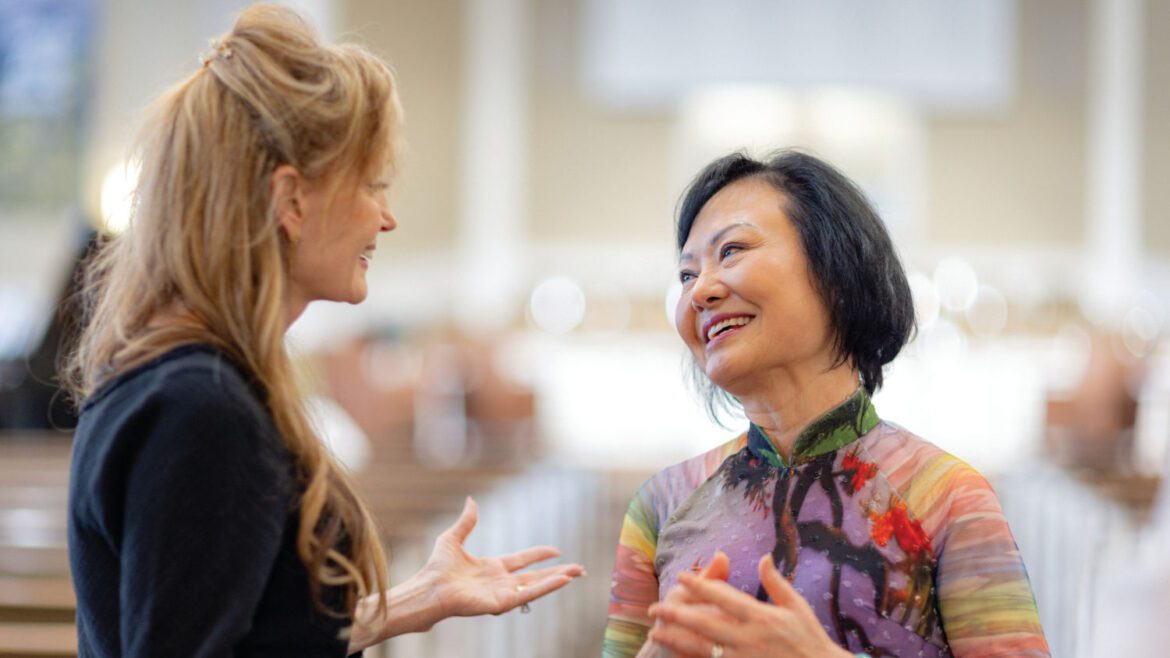PHAN THI KIM PHUC had only recently turned 9 years old when a soldier told her to run. It was June 8, 1972, in the latter years of the Vietnam War. Kim Phuc ran, but she stopped to help a child. Then the fire came. It burned away her clothing, and the anguish of “the little napalm girl” was captured for the world by an Associated Press photographer. Following many painful years of recovery, she became a victim again—this time as a symbol by the communist government. Today, Kim Phuc has regained her spirituality, her wellbeing. She has launched The KIM Foundation International to help child-victims of war, violence, and deprivation. As she so eloquently says, “The only thing that I hope people learn from my life story is that ‘the little napalm girl’ is no longer a victim.”
You are known globally from a photograph taken during the Vietnam War and carried on the cover of Time Magazine. What is your name?
My name is Kim Phuc Phan Thi, but people know me as “the little Napalm girl.” Kim Phuc is my first name which means golden happiness. Kim means gold, and Phuc happiness so Kim Phuc together translates to Golden Happiness.
Happiness . . . so you were blessed from the very beginning?
Yes. It was my father who named me.
How many children did your parents have?
In total my mother carried 10 children, but because of a miscarriage and death at a young age, there were eight children. There are seven remaining because my fifth brother passed away in 2004.
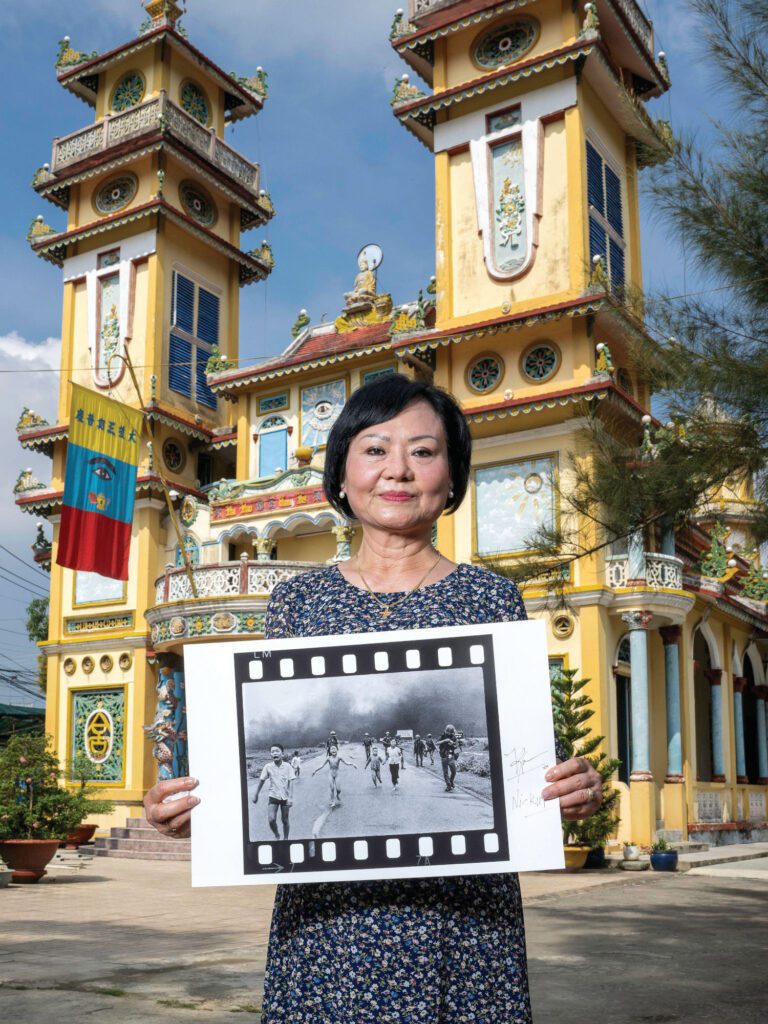
Phan Thi Kim Phuc, the main subject of Pulitzer Prize-winning photographer Nick Ut’s Terror of War photo taken during the Vietnam War on June 8, 1972, stands in front of the Cao Dai Temple in Trang Bàng where she was hit by napalm.
PHOTOGRAPH BY ZUMA PRESS, INC. / ALAMY STOCK PHOTO
Kim, I am so sorry. Can you tell our readers about the day you were named “the little Napalm girl?”
We were hiding in the Cao Dai temple where the religious group was gathered. They created Cao Dai in Vietnam in 1925 and most of the people follow it in our province. I had just turned nine years old.
What did it feel like hiding in the Cao Dai temple?
As a child, I do not remember any fear at all. I was playing with my favorite cousin, Danh, when a black bird flew into the temple. My cousin, my brother, and I started chasing the bird. It was just after lunch and I still remember the moment when the soldier told us to leave quickly because if we stayed where we were, we would be killed. He said, “Just run.” We were with the South Vietnamese, twenty-fifth division soldiers, who were tasked with protecting the adults, children, and babies. We hid in that temple because we believed the temple was a holy place, and therefore nothing bad would happen to us if we assembled there. But it was wartime, and we were all wrong.
Why did the soldiers tell you to run for your life?
They saw the “color mark” which meant the temple was about to be bombed. As soon as the soldiers ordered us to run out of that temple, the children ran first because we were faster than the others. I began running with my brothers but left them to help my three-year-old cousin until a soldier came along and picked him up. Because my brothers were faster than me, they missed that fire from the napalm bomb. But because I slowed down to help my cousin, I was caught in the bomb and burned. My mom barely missed being injured.
Was the cousin that perished the child you slowed down to help?
Yes. He was three years old. We were together, running from that spot up to the front of the temple. I heard a very loud sound and saw a big airplane as I looked up. At that time, I saw four bombs landing and heard the noise, boom, boom, boom, boom. Suddenly fire was everywhere around me which burned off my clothes. I saw the fire all over my left arm, and I used my right hand to wipe it up, which is why I was burned there too (holds up her right hand with noticeable burns). I learned that the soldier who was carrying my little cousin was burned so badly that he couldn’t carry him anymore and threw him on the street. I was so terrified. I do not remember seeing anybody around me, just the fire. I still remember what I was thinking.
What were you thinking?
I thought, oh my goodness, I will be ugly. I will not be normal, and people will see me in a different way. I was terrified, horrified, and so scared. I ran through the fire and saw two of my brothers and two of my cousins and some of the South Vietnamese soldiers. All together we ran and ran and ran on the road. That is all I remember.
There was another child that perished, another cousin who was a brother to the three-year-old . . .
Yes. They are brothers.
Were they twins?
No, one child was three years old and the other was nine months. Their mother is my aunt who was also burned on her leg. Like me, she used her hands to “wipe up” the fire with her hand, which is why her hand was also burned. Because of the burns, she ran back to the temple. My mom told me that she was not able to carry the nine-month-old baby, so another
uncle picked up the baby.
But it was too late.
Of course. I learned later, but at that time, I didn’t know, that one hour later, the three-year-old passed away and the baby died about two months later.
So, he struggled for two months?
Yes. Because of the burns . . .
Who is Uncle Ut and what is his connection to you?
Uncle Ut is the photographer who took the picture of me running down the street after the napalm had burned my clothing off. He was the person who carried the injured children to Cu Chi hospital nearby my village.
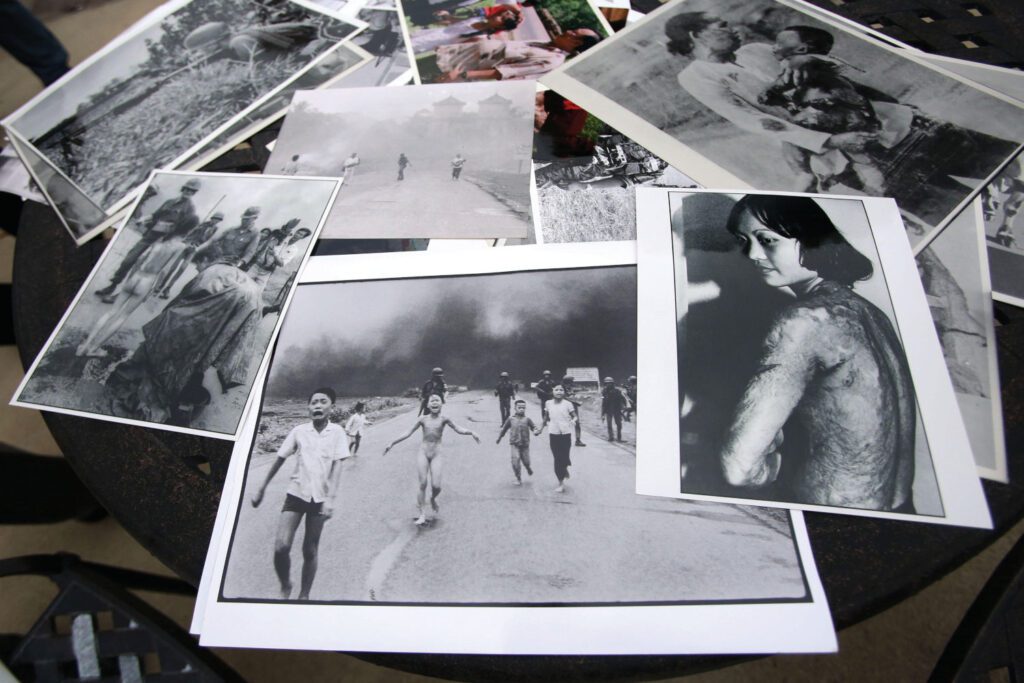
Photographer Nick Ut’s pictures of the ‘Napalm Girl’ on June 03, 2012, at the Liberty Baptist Church in Newport Beach, California. Phan Thi Kim Phuc was the child depicted in the Pulitzer Prize-winning photograph taken during the Vietnam War on June 8, 1972.
PHOTOGRAPH BY ZUMA PRESS, INC. / ALAMY STOCK PHOTO
Do you remember seeing Uncle Ut?
No, as a child I didn’t know who Uncle Ut was yet. I just kept running and running until I felt so tired, I could not run anymore, so I stopped. I saw many, many people standing on the street. I said it was “Too hot. Too hot.” One of the soldiers gave me some water to drink because each of the soldiers had a canteen filled with water. I drank the water and I continued to say, it was “Too hot. Too hot.” He was trying to help me, which is why he poured water on me.
To pour water on a burn victim is not helpful at all . . .
Absolutely not. I think he was a young soldier. Now they know about the horrible effects of napalm, but not back then. Later, I learned how napalm reacts with oxygen. When he poured water onto the affected burn, the oxygen in the water literally cooked me. As soon as the water was poured over me, I passed out.
Because there is so much pain?
Yes, the water causes the burn to go deeper, which sounds bad, right? But I am so thankful. Do you know why? Because if I had remained conscious, I would have had more pain. Yes. But when I passed out, it ceased. I didn’t feel as much pain as I could have.
You passed out quite a bit as they were treating you. What do you remember?
I do not remember anything during the time that followed. I can only tell you what I was told by Uncle Ut, my mom, the
reporter, and the doctor.
But you were in the hospital for over a year. Do you remember when you first became conscious?
I remember that the nurses came every morning to wake me up and move me to the burn bath to clean the burned skin off. It was a terrible moment for me, I called it the “death time.”
Can you tell our readers the “Uncle Ut story?”
Uncle Ut was standing so close to us when he saw me running from the fire, that he took my picture. There were journalists assembled from everywhere, Vietnam, America, and England. They were grouped together, blocked in, and could not pass on the road. So, when the bombs dropped, they captured everything on film, everything.
When I saw the film footage, 10 years later, I was just amazed, speechless really. I could hear the voice of my grandma as she fled carrying my cousin. For the decade prior to watching the film footage, I just saw a still picture. But when I saw that clip, I just couldn’t believe why anyone would let me run for so long and why no one helped me. They all saw me running from the flames and on fire, yet they let me keep running while they filmed me. So, I asked Uncle Ut who explained at the time they believed they had to film first and would help me later.
One of my uncles asked Uncle Ut to bring the wounded children to the hospital because he had transportation. He drove us to a small hospital-like clinic. When he stopped in the front, they refused to take us in because of the severity of our
injuries. They saw our burns and they said, “No, we can’t help.” But when Uncle Ut threatened to expose them (by working
with the AP) in the media they were frightened by the potential negative publicity, which is why they took the children in. He said, “If you do not admit these children today, tomorrow your hospital will be on the front page of the newspapers.”
From there you were transported to multiple hospitals.
Exactly. I have no idea how many, which is a good thing because I don’t remember anything. I asked my brother, who was only four or five years old at the time, what he remembered. He recalled me being dropped off at the clinic. The nurse or the doctor put the two jars of Vaseline to cover my burned skin, and I was bandaged.
Uncle Ut said after they admitted me into that clinic, he left me there because he didn’t know what else to do. He then
went to the darkroom in Saigon and developed his roll of film, which is how they found the picture.
A Pulitzer Prize-winning picture.
Yes. The next morning, he went back to the village to find out what my name was for the credits. He was also wounded there, by a Vietcong mortar bomb. His friends brought him back to Saigon. When they finally learned my name, the story broke.
Can you also tell our readers “Your mother’s story?”
My mom’s story is incredible. There are no words to explain how people can inflict suffering on others. My mom knew from my uncle and the village people that I had been severely burned. From the village, she walked for three days, through the fields and sometimes on the road, because it was forbidden to have a car. She traveled with my brother who was only 11 years old at that time. Yes. My entire family searched for me. My father, my uncle, and my mother each went to different hospitals looking for me. They felt they could cover more territory by dividing. When my mom finally arrived at the
Children’s Hospital, she was terribly disappointed because she couldn’t find me anywhere. She told one of the workers who was cleaning the hospital that she was not able to find her child who was burned. She explained that I was nine years old and what had happened. He said that if she couldn’t find me anywhere on the floor, there would be only one place left and he pointed in the direction of the morgue.
My fifth brother overheard the conversation and because he ran faster than my mom, he found me there.
In the morgue?
In the morgue.
But you were obviously alive?
Exactly. After three days of searching, she found me in the morgue. Those details really upset me. But as I will tell you later, it was a miracle.
What happened after your brother found you in the morgue?
My brother found me first and called “Mommy, mommy, my sister is here.” I asked her later what she witnessed when she found me. Because for three days nobody had cared for me or my burns, I smelled horrible. You know, the heart of a mother, she just picked me up to carry me home because she had no more hope. When she picked me up, I had very shallow breathing, and one deep breath, like I was dying, but not completely dead. Neither she nor my brother expected me to survive, and they were taking my body back to the village for burial.
And then a miracle happened. As she was carrying my body out of the hospital, literally in the entrance, my dad arrived from another hospital. At that exact moment, my father recognized an old friend who he had studied with in the university. Their paths crossed at the same time. Because my father’s old friend wore the uniform of the doctor, my father recognized him and pleaded, “Please help my child. She was burned in our village in the war . . . and now she’s dying. Please help her if you can.” My dad knew nothing about Napalm and thought it was just burn. The doctor was on his way home but was delayed waiting for something. It was a miracle. He made a phone call and made arrangements for an ambulance to transport me to the Barsky Burn Clinic, an American Hospital. Arthur Barsky was a missionary doctor who worked post-Hiroshima to help the survivors. When he was done, he moved to Vietnam. The Barsky Burn Clinic is a private clinic. There he gathered international doctors who wanted to volunteer in Vietnam whether for two weeks, one week, or one month. My family went with me to the Barsky Burn Clinic. 25 years later, I met the doctor who admitted me.
You call it a miracle; some call this God’s grace. What do you think?
For me, it was by the grace of God, a miracle. I believe that God had the plan specifically for that little girl. I was not a coincidence.
Why does God pick some and not other children?
I believe that is in his power, “His will be done.” I have asked myself many times before, “Why me?” and then I ask back, “Why not me?” Then through it all, I remember how much I suffered, how much I endured . . . beginning with the photograph of me running on that road. I have no idea . . . if not by the grace of God and not by his love, why me? I am not here to answer all the questions, but I believe in God; He is invisible, spiritual. His power, His freedom to choose, His love—these are things I am still learning, still experiencing. That faith helped me to move on, gave me strength, and answered so many questions and so much doubt. On that “fire road” that I went through, that is my path.
How many surgeries did you have in the first year and a half?
16 surgeries, primarily for skin grafts. I had very deep burns, in some places and less in others.
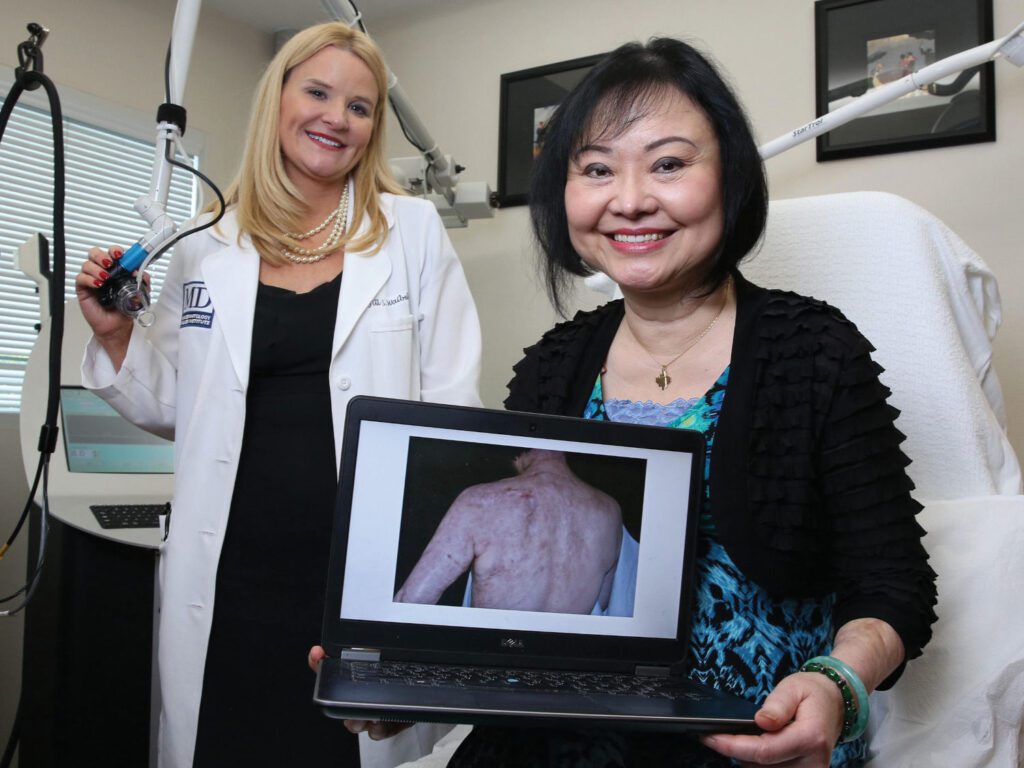
Miami, USA. 06th Jan, 2017. Phan Thi Kim Phuc, 53, was all smiles in Miami, where she was preparing for her final laser treatment from Dr. Jill Waibel of the Miami Dermatology and Laser Institute. Kim holds a laptop showing one of the first photos taken of her back by Dr. Waibel before all of the healing Lumenis Ultra Pulse laser treatments she has received.
PHOTOGRAPH BY TRIBUNE CONTENT AGENCY LLC / ALAMY STOCK PHOTO
At the time they required 35% healthy skin for the grafting to be successful. If you had less than 35% you could not survive . . .
Yes, and that is exactly what I had, 35 % healthy skin. You see, again, a miracle. Recently, I was in Quebec, and I visited the lab where today they can harvest skin and the burn victims do not have to suffer like I did. They can do this by removing a little bit of your healthy skin.
If you counted every surgery and laser treatment, how many procedures have you endured?
In the first year, I received 16 skin transplant operations. And then in 1984, I did one in Germany, it was 17. I have done
13 laser treatments.
30 procedures. On a scale of 1-10, what is the pain level?
The 13 laser treatments have really helped with the pain. The scale of the pain from zero to 10 is now in the middle.
I have read that you do not take medication. Yet, in the formative years of your recovery, you were in horrific pain and suffered depression.
I lived in a very hot climate. But with the scar tissue, I do not have any pores to sweat. Napalm is a very dangerous chemical because of the way in which the burn heals causes tremendous physical pain. When I became older the emotional suffering hit. I was mad about what happened which is why I was so shy. My personality is quiet. Like with most of the Vietnamese people, we are very quiet, and we just endure our suffering.
How did you transition back to living a normal life after experiencing such physical and mental trauma?
When I was hospitalized, every patient was treated the same. No one was special, despite their injuries, except the doctor or nurses. But when I came home, it became real to me that this was my life. No one around me was scarred or wounded. My friends were afraid of how I looked, and they feared my scars. They looked at me like I was disabled.
Did you feel alone?
Yes. I felt alone and I questioned . . . I asked why. I wished they would just come to my home, hug me, and play, like before. I missed them. But they never came.
At some point South Vietnam fell and you became a puppet for propaganda. How did the government reach out to you?
They did not find me right away, but 10 years later. In the middle of quietness, the storm came. Suddenly four of the government officers travelled to my school. They stared at me from head to toe and couldn’t believe it was me, because they didn’t see any scars.
You had them covered?
Of course. I wore long sleeves to hide them. The officer looked at me and asked, “Are you Kim Phuc?” From that point forward, journalists from all over the world visited Vietnam and wanted to interview the “little napalm girl.” The government in Tay Ninh was so happy and proud that they had found me. Every time I was interviewed and filmed, they would take me back to the province Tay Ninh where the government offices were, and then they took me to Trang Bang, the very place where they dropped the bomb.
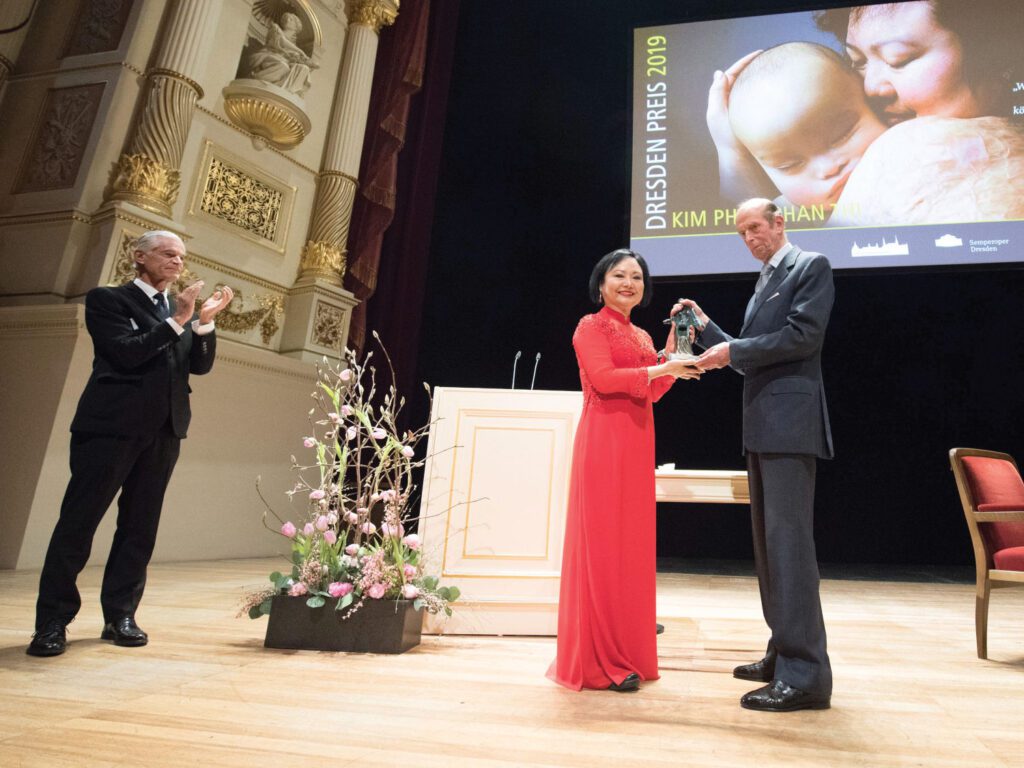
In 2019 Phan Thi Kim Phuc received the 10th International Peace Prize from Prince Edward, Duke of Kent at the Semper Opera, in Dresden, Germany.
PHOTOGRAPH BY DPA PICTURE ALLIANCE / ALAMY STOCK PHOTO
How many times did you have to do that?
It was countless.
Did you not feel betrayed or angry that those people who hurt you were the same ones who were exploiting you?
Yes. But at the beginning, honestly, I didn’t feel that way. I was happy because suddenly, as an ordinary girl, I had a lot of attention with interviews, pictures, and filming, like a celebrity.
Did they help your family during that time as well?
No. You know communists, they threatened my mom and dad. I became a very, very important person at that time, a symbol.
Why did they feel that way? Because you survived it?
Yes, because I was the subject of a very famous picture known throughout the world. And the napalm that injured me represented South Vietnamese and Americans working together, the American war in Vietnam.
Do you know why? Because you are a beautiful woman who represents everything lovely about Vietnam, perhaps with hidden scars . . . in your quiet elegant way.
I still survived.
Yes, you survived and thrived.
But because the picture was so famous, they wanted to control me. Once they decided I represented the symbol for war, they wanted me to work for them as propaganda. They stopped my studies. They took back my family’s residency and forced me back to our province to work. My principal, teachers, and everyone called me, saying “Kim, we love you. You can study here but it is out of our control. The Tay Ninh province has revoked your paperwork, so you are not allowed to remain here.” That decision destroyed my future.
I am sure it crushed your dreams.
I had no more hope. Immediately what came to my mind, my soul, was that I had become another victim. Why me again? I had no power and I just wanted to escape.
You were quite young?
Yes. I had just turned 19 years old, and it was the period before I became Christian. That period of my life felt like an eternity because of how much hatred, bitterness, and anger I held inside. I was devoted to Cao Dai and strived to be the best person possible. In their doctrine, you must be good in this life, for the next life to be good. The theory is that if you do good work, it will come back to you. I kept asking, why do I have to suffer like this?
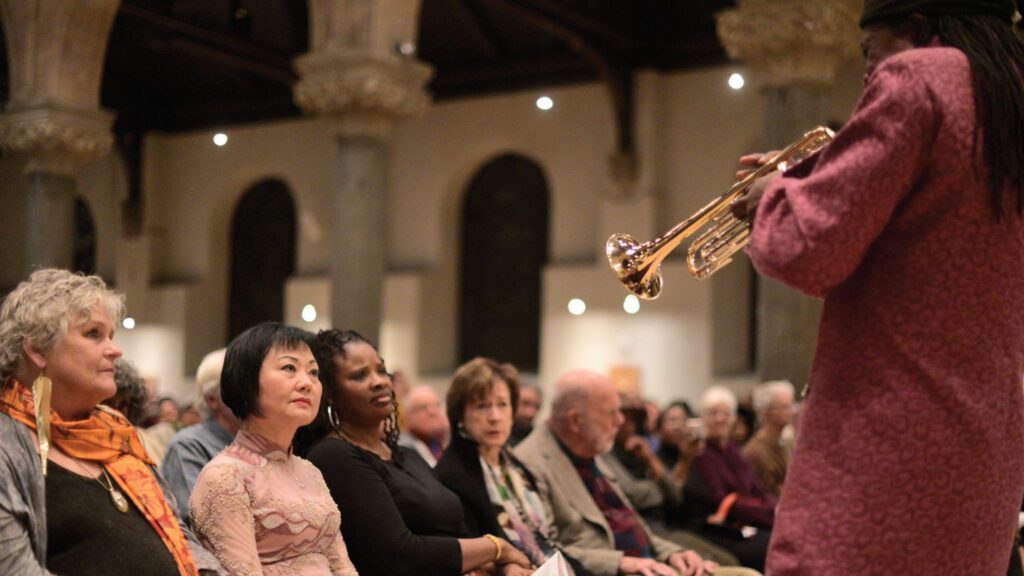
Phan Thi Kim Phuc reacts when Hannibal Lokumbe performs his 1973 composition Children of the Fire for the first time in the presence of the Girl in the Picture, in Philadelphia, PA, on December 7, 2019.
PHOTOGRAPH BY NURPHOTO SRL / ALAMY STOCK PHOTO
The Cao Dai religion involves reincarnation of sorts.
Yes. It is said that if a person eats chicken, pork, or beef, in the next life, they transform into that animal. I tried to do my best. But when I was faced with the government from Tay Ninh treating me that way, it caused me so much pain, hatred, and anger; I reverted to that little girl, the victim of war. My normal friends were still able to study. But why not me?
Being a victim of war, what can you share with the reader?
Nothing positive comes from war.. . . . the pain, the loss, the bitterness. Victims of war suffer not only from what is happening from outside . . . they might lose everything tangible and material, but with a healthy body and mind they can still endure and overcome. But because my burns were so severe, I was physically unable to rebound. I lost everything including my spirituality. I devoted so much to praying to the many gods, but none of them answered my prayer.
Were your parents aware of your feelings of desperation?
My parents had such a strong faith in Cao Dai. Yes. They were also suffering and often cried, which did not bring me any peace. When I became Christian, I told them I believed in Jesus Christ and would not follow Cao Dai. My mom was angry and felt that I had betrayed her religion.
Did she ever convert to Christianity or is she still a Cao Dai?
My entire family has converted to Christianity.
I have interviewed lots of people experiencing moments of desperation, hopelessness, and despair. They ask God, where are you? Why me?
I have been there.
What do you tell those people?
I tell them that I understand them perfectly because I was there. Continue seeking for the purpose of your life and the answers to your questions, and never give up hope; reach out for help.
This idea of perseverance and never giving up is a characteristic that your mother had. Is that hard-wired in you?
Yes. I think I got that from her, the will to never give up.
Can you share three things a victim of war can do to move themselves forward instead of staying in a space of darkness?
Number one is to never give up hope, even though I almost did. I fantasized about dying in a car accident because I thought if I died, I would have no more suffering.
Number two is to seek the truth. Why did this happen to me? Where are you, God? Because believe me, every child growing up in any country with war is asking God something. I am not speaking about religion either, but just God, because God gives humans something to believe in. I would tell them, keep seeking, looking, learning. Open your mind, open your heart. Never, never say or accept that what is happening to you “is my destiny.”
Number three is to practice the Three D’s. The first D is to have desire. The second D is to be determined and the third D is to have discipline. I must discipline myself, to fulfill my desire and determination. Without discipline, you cannot have a good result.
I want to talk to you about religion and forgiveness, complex concepts.
Believe me it is. Religion alone is not the answer. Just like the clothes you wear, or your name… religion describes a component about you. I am Christian, I am Buddhist. I am Hindu. I am Muslim . . . but it is just a name. My personal relationship, between God and me, is what changed my heart, changed my attitude, changed my behavior, and taught me forgiveness.
When you were in the most pain and suffering, how were you able to distract yourself to get through it . . . and did it help when you did good deeds for others?
Yes. I learned that concept later in my journey but at the beginning, I just focused on my pain. I learned to distract myself
by praying to God. I would ask, “Please give me enough strength to carry on with the pain.” The next step was to serve other people. When the pain comes, I take that time, run to the Lord, and I pray for hours and hours. For the many people that are in my heart, I pray for them. I include my family, people who are close to me, and friends all over the world. The more I pray, the more peace I have. During the time I am experiencing pain physically, I use my mind and I pray. At the end, wow, the pain is gone. The more I pray, the more peace I have. It has really helped me to have a close relationship with God by praying and trusting him.
The pain and the scars are my protection as I serve as a Goodwill Ambassador for UNESCO and promote The KIM
Foundation International.
But you know that you are beautiful, don’t you?
I know. God showed me that. I grew up with the scars. I compared even my worst scars to buffalo skin because my scars had no pores and were really rough to the touch. But I learned how to conquer and overcome that kind of ugliness, from a little girl seeing my burnt skin because I changed my attitude. God made a
mark on me to remind me, “I am with you, Kim. You are nothing. I’m with you. I can make you beautiful.” That is the beauty. It comes from inside, not from outside. You see that is everything.
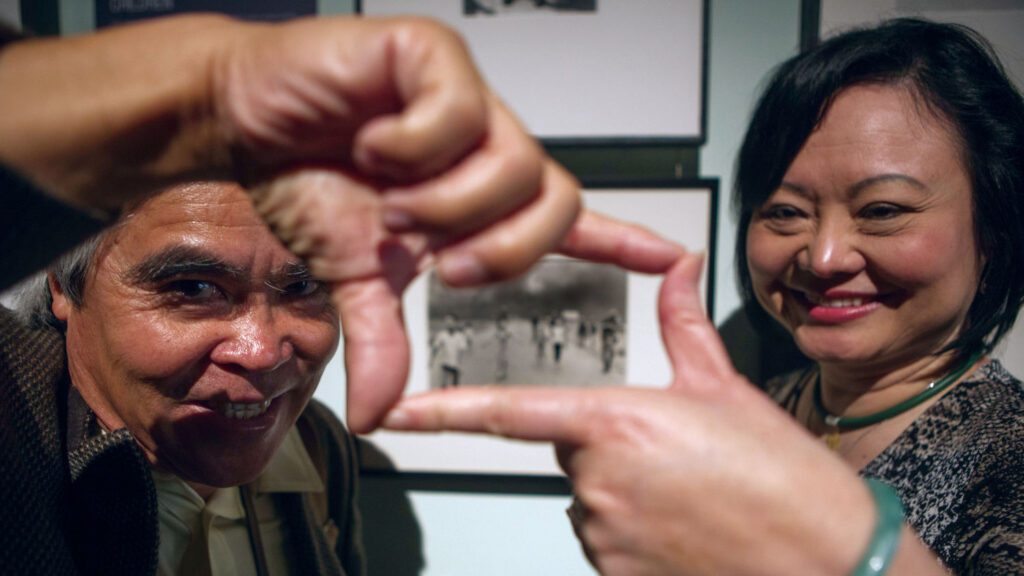
Vietnam war survivor Phan Thi Kim Phuc, ‘’Napalm Girl ‘’ and Pulitzer Prize-winning Associated Press photographer Nick Ut visit and speak at War/Photography at Annenberg Space for Photography in Los Angeles.
PHOTOGRAPH BY ZUMA PRESS, INC. / ALAMY STOCK PHOTO
See, I see that in you. I see the beauty.
You can see that the beauty, the peace, the joy is from inside out, not from outside in. Every victim of war needs to have that. God, not religion, don’t talk about religion. But God suffered so much for us through Jesus. He has the power to mend my broken body and heal my skin. All kinds of ugliness become his beautiful art. I believe that living with beauty, love, and forgiveness, that God makes us beautiful art. A beautiful vessel.
Have you been back to Vietnam?
Yes. In 1996, I applied for a visa. They didn’t answer me. When my fifth brother passed away in 2004, I said, this is the time I must go back and apply for the visa. They allowed me to go for one month, I had to be very low-key.
And was that emotional for you?
Yes. I took my children back to the place that, on the road, was where the photo was taken, and it made a strong impression on them. “Mommy we know your story, but right now, it has become a reality.” We stayed in the very place that they bombed. My stories became part of history.
How old are your boys?
My Thomas, 29. My second, Stephen, 26. I have four grandchildren. Yeah. Two boys and two girls. Yes.
The KIM Foundation International. Yes. you have so many initiatives that are in play at any given time. How can a person donate to The KIM Foundation International?
Visit my website, kimfoundation.com.
What do you want to be remembered for?
I want my story to represent the love of God. It doesn’t matter what happens to you, God is in control. The only thing that I hope people learn from my life story is that the little napalm girl is no longer a victim. She is a survivor calling out for peace and joy. I want people to know that the “little napalm girl” found both.
My son Thomas is in this picture taken by my friend and photographer Ann Bayin. She took the picture showing the scar on my back. The more I look at the photograph I love it because I have so many more scars. I wanted to create something else. The symbolism of the picture of my back represents that although I still carry on my past, I won’t forget it. How can I forget? But then you see the beautiful skin of my son Thomas. It means something new is coming and reminds me to never stay in the past. My smile represents hope.
There are three points I want people to remember from this photograph. War did not define or kill me. The war could not
destroy my hope. The war could not kill my future. You see the love between a mother and son. When you see him, you don’t see his face, but you see his ear is so close to my mouth… as I whisper my story to him about what I experienced
as a child. He listens carefully as I teach him. He looks forward to the future and does not look back.
I travel around the world to share my story, to tell people how horrible war is, but also how beautiful the world can be. If
everyone could learn to live with love, hope, and forgiveness, we would not have war.
I challenge everyone, if that little girl can do it, you can do it too. I encourage people not to wait too long. Just be yourself. Be a blessing. You can help yourself, another person, people in your community, a nation, and all over the world. The value of one individual is unending.
We cannot change history, but with love, we can heal the future. My story and what it represents in this photograph focuses on love, forgiveness, and hope. I want people to remember that and not see that “little napalm girl” in a horrible picture.

